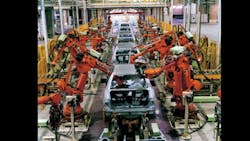Take a Bow -- Manufacturing's Leading Way Out of Recession
I had the pleasure of listening to John Brandt, CEO, MPI Group and Ned Hill, Ph.D., Dean, Maxine Goodman Levin College of Urban Affairs, Cleveland State University deliver the good news.
While the speeches last night were about the future of U.S. manufacturing, it was the positive current news that buoyed the audience.
Hill pointed out that there were three very distinct factors that have converged to enable manufacturing to push ahead of the general recovery; value of the dollar, the high cost of shipping and positive energy developments.
The down side of course is that the sector is not adding jobs back as quickly. And the reason for that is very different than in other past recoveries. It used to be that you knew you would go back to your old job. Now however your old job isn't there anymore. The company used the time during the recession to become more productive and to update machinery. Often the former employee doesn't have the skills necessary to work that new machine. Hill's suggestion is to bring back apprentice and internship programs.
Brandt concurred that companies who had robust training programs for their employees performed well. This was a differentiator for the hundreds of companies he surveys. And hand-in-hand with training is the concept of empowering workers through self-directed work. This is the second part of the formula for success.
Many of the companies have "done it right" during the tough times. They focused on innovation, kept close to their customers, kept invested in continous improvement and contained costs, Hill said.
Innovation, in all of its form, takes the top spot however. Brandt pointed out that consumer never even knew they wanted iPhones etc. Manufacturers must always been looking toward the next thing.
While it's great to fulfill customers' needs, they must look ahead to future customers. And customers, current and future, are located beyond the U.S., Brandt points out. The success of the small-to-medium sized businesses are in large part due to their ability to deliver to a global market.
About the Author
Adrienne Selko Blog
Senior Editor
Focus: Expansion Management & the Biotech & Life Sciences Industries
Email: [email protected]
Follow Adrienne on Twitter: @ASelkoIW
Call: 216-931-9235
Senior Editor Adrienne Selko manages IndustryWeek’s Expansion Management, delivering ideas and information about how successful manufacturers leverage location to gain competitive advantage. She explores the strategies behind why companies located their headquarters, research institutes, factories, warehouse and distribution centers and other facilities where they did, and how they benefit from the decision.
Adrienne is also the editorial coordinator of the IndustryWeek Expansion Management Roundtable events, which unites economic development professionals to network and discuss the latest trends in site location.
As well, Adrienne tells the stories of successful companies in the biotechnology and life sciences industries.
In the past, Adrienne has managed IndustryWeek’s award-winning website, overseeing eNewletters, webinars, and contributed content. Before joining the staff, Adrienne was managing editor of corporate publications at a large regional financial institution. She also ran a public relations and marketing company that published a best-selling healthcare book.
Adrienne received a bachelor’s of business administration from the University of Michigan and is especially interested in wellness and natural health.
